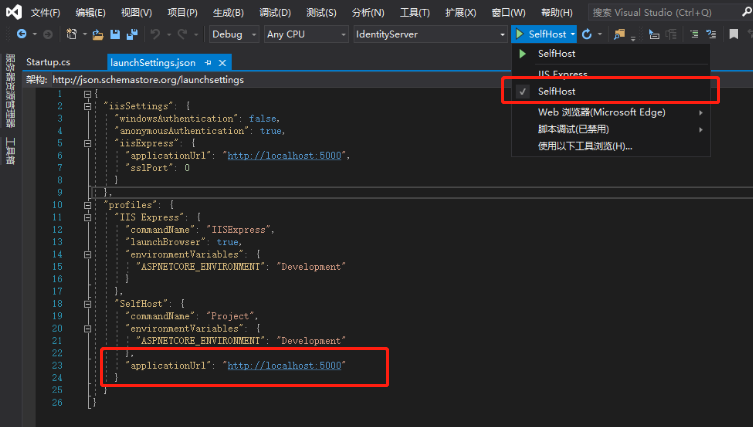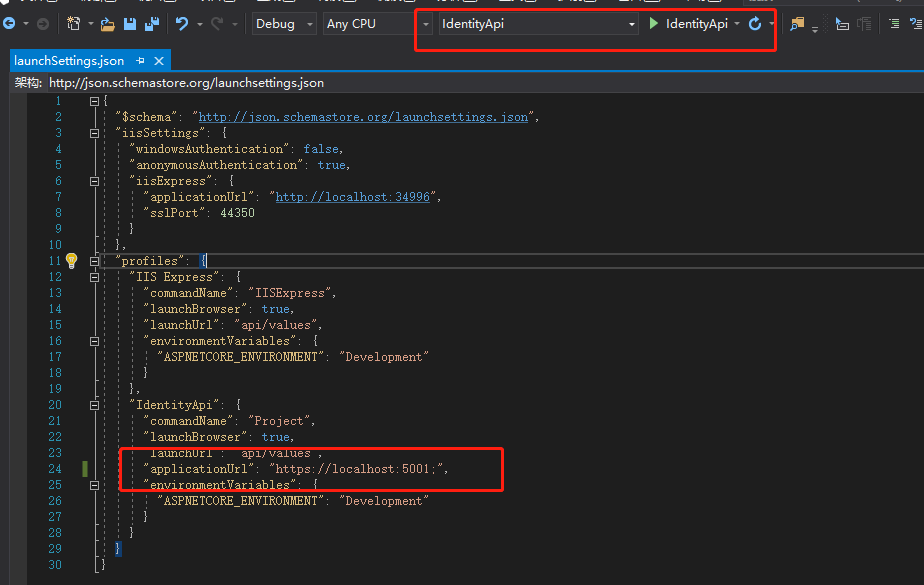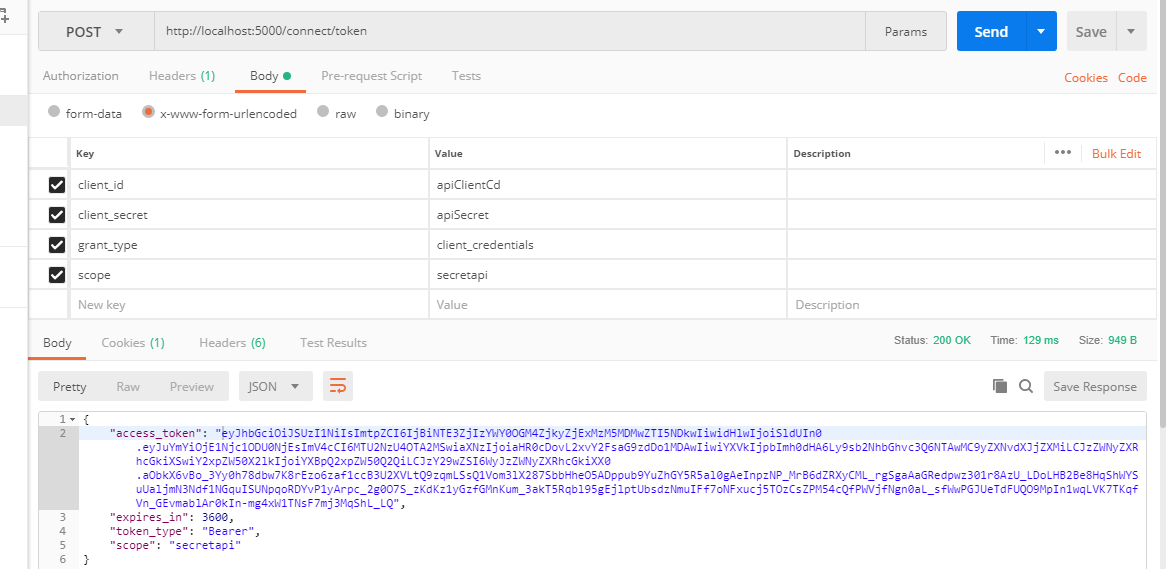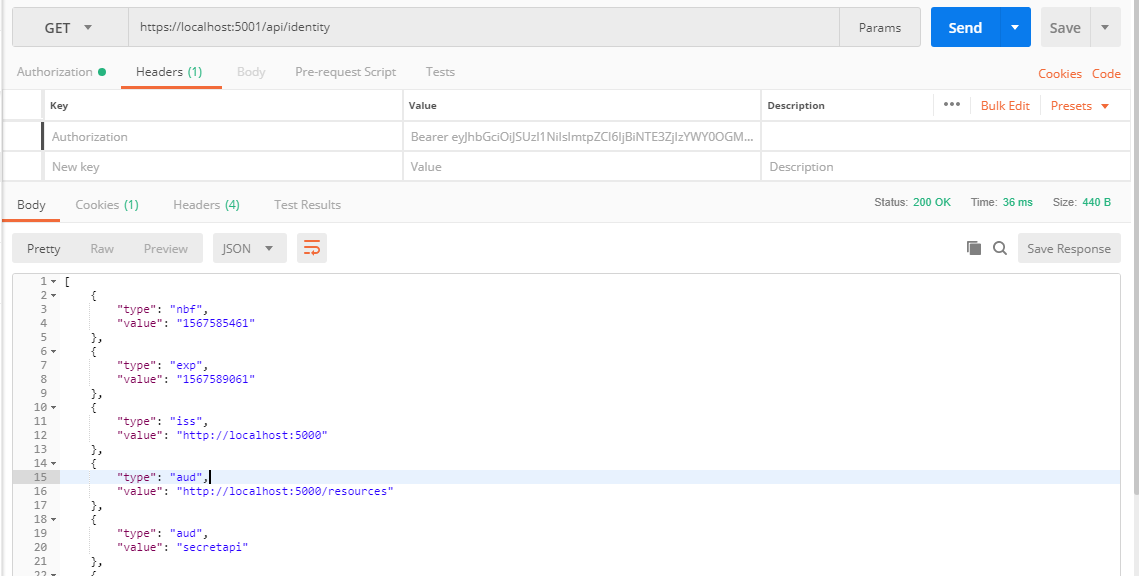一,准备内容
IdentityServer4 是Asp.net core的一个中间件,用于添加符合OpenId Connect和OAuth2.0规范的终端到Asp.net Core应用。在这里简单介绍一下Openid和OAuth2.0。
OpenId:用户身份认证(Authentication )。当用户(End User)在微信、Google等OpenId提供者(OpenID Provider)平台注册账户时会产生一个身份标识,这个身份标识就是OpenId,当用户登录第三方应用(Relying Part)时如果Relying Part支持OpenId登录,会生成一个带有重定向地址的Url跳至OpenId Provider平台登录界面,用户登录成功后,根据重定向地址带着OpenId跳回Relying Part,标识着用户身份认证成功,该用户在OpenId Provider平台有注册。Relying Part根据OpenId自动注册账户,至此身份认证结束。有时Relying Part需要从Openid Provider那获取该用户的更多信息或资源,OpenId Provider需要对Relying Part的请求进行授权管理,这时就用要到OAuth2.0。
OAuth2.0:用户访问授权(Authorization)。OAuth2.0是一个JWT(Json Web Token ,Json格式Web令牌)解决方案。其最终目的是给用户一个包含加密令牌的JSON字符串,这个令牌内包含授权信息,决定了该用户可以访问那些资源。OAuth2.0协议规定了4种取得令牌的方式,可以参考这篇文章OAuth2.0的四种方式。
Openid Connect:实际上就是将Openid与OAuth2.0结合起来,解决身份认证和身份授权的问题。
客户端模式只对客户端进行授权,不涉及到用户信息。如果你的api需要提供到第三方应用,第三方应用自己做用户授权,不需要用到你的用户资源,就可以用客户端模式,只对客户端进行授权访问api资源。
二,创建Asp.net Core 项目
微软提供了一些针对IdentityServer4的项目模板,在命令行中输入” dotnet new -i IdentityServer4.Templates“即可安装,安装好后可以看到当前已安装的项目模板,其中有一个"is4empty",其实就是一个asp.net core 应用装了IdentityServer4包。在命令行中输入:dotnet new is4empty -n Projectname 就会根据这个模板生成一个新项目。下图是我的项目,一个api客户端、一个mvc客户端,一个identityserver4服务端,其中Api客户端是受保护的Api资源,Mvc客户端是第三方客户端,用于访问被保护的Api客户端,可以看成是任意后端程序。

- 配置IdentityServer服务器,如果是用的is4empty模板创建的项目,已经有一些简单配置,后面我们慢慢深化
public void ConfigureServices(IServiceCollection services)
{
//添加IdentityServer
var builder = services.AddIdentityServer()
//身份信息授权资源
.AddInMemoryIdentityResources(Config.GetIdentityResources())
//API访问授权资源
.AddInMemoryApiResources(Config.GetApis())
//添加客户端
.AddInMemoryClients(Config.GetClients());
if (Environment.IsDevelopment())
{
builder.AddDeveloperSigningCredential();
}
else
{
throw new Exception("need to configure key material");
}
}
public void Configure(IApplicationBuilder app)
{
if (Environment.IsDevelopment())
{
app.UseDeveloperExceptionPage();
}
//使用IdentityServer中间件
app.UseIdentityServer();
}
为了能更好的查看调试日志,使用窗口调试,可以在Properties/launchSettings.json中可以更改监听地址,默认为5000

启动项目后使用浏览器打开:http://localhost:5000/.well-known/openid-configuration。可以看到identityserver4的discover说明。
三,配置IdentityServer4
1,添加ApiResource:修改IdentityServer项目的Config类的GetClients方法,添加一个api资源(ApiResource)。每个被保护的API项目必需有对应一个ApiResource,一个ApiResource可以有被多个API标识,客户端请求令牌时根据ApiResource名称决定是否有权限访问这个API。
public static IEnumerable<ApiResource> GetApis()
{
return new ApiResource[] {
//secretapi:标识名称,Secret Api:显示名称,可以自定义
new ApiResource("secretapi","Secret Api")
};
}
2,添加客户端模式用户:定义好ApiResouce后,再来添加一个客户端,使得这个客户端可以访问secretapi这个资源。修改Config类中的GetClients方法,添加一个用户用于支持客户端模式的请求。
public static IEnumerable<Client> GetClients()
{
return new Client[] {
new Client()
{
//客户端Id
ClientId="apiClientCd",
//客户端密码
ClientSecrets={new Secret("apiSecret".Sha256()) },
//客户端授权类型,ClientCredentials:客户端凭证方式
AllowedGrantTypes=GrantTypes.ClientCredentials,
//允许访问的资源
AllowedScopes={
"secretapi"
}
}
};
}
四,配置API客户端
1,配置API项目监听端口和调试方式

2,配置Api项目认证
IdentityApi.Startup.cs
public void ConfigureServices(IServiceCollection services)
{
services.AddMvc().SetCompatibilityVersion(CompatibilityVersion.Version_2_2);
services.AddAuthentication("Bearer").AddJwtBearer(r => {
//认证地址
r.Authority = "http://localhost:5000";
//权限标识
r.Audience = "secretapi";
//是否必需HTTPS
r.RequireHttpsMetadata = false;
});
}
// This method gets called by the runtime. Use this method to configure the HTTP request pipeline.
public void Configure(IApplicationBuilder app, IHostingEnvironment env)
{
if (env.IsDevelopment())
{
app.UseDeveloperExceptionPage();
}
else
{
// The default HSTS value is 30 days. You may want to change this for production scenarios, see https://aka.ms/aspnetcore-hsts.
app.UseHsts();
}
app.UseHttpsRedirection();
//使用认证中间件
app.UseAuthentication();
app.UseMvcWithDefaultRoute();
}
3,添加接口:新建一个空的Api控制器(IdentityController),在这个控制器中添加一个Api:GetUserClaims
[ApiController]
public class IdentityController : ControllerBase
{
[HttpGet]
[Route("api/identity")]
[Microsoft.AspNetCore.Authorization.Authorize]
public object GetUserClaims()
{
return User.Claims.Select(r => new { r.Type, r.Value });
}
}
这时GetUserClaims这个Api是访问不了的,用PostMan访问时返回401未认证状态

五,访问受保护的Api
要访问上面那个受保护的Api,分为2步,第一步从IdentityServer获取token,第二步把这个token使用Bearer authorization 方式添加到Http请求头。
1,在IdentityMvc项目访问受保护的Api
IdentityMvc项目安装一个Nuget包:IdentityModel,这个包对HttpClient对象有扩写,封装了一些IdentityServer的常用请求。修改IdentityServer的监听端口为5002,使用窗口调试。
在IdentityMvc的HomeController.cs新增一个控制器GetData
public async Task<IActionResult> GetData()
{
var client = new HttpClient();
var disco = await client.GetDiscoveryDocumentAsync("http://localhost:5000");
if (disco.IsError)
return new JsonResult(new { err=disco.Error});
var token= await client.RequestClientCredentialsTokenAsync(new ClientCredentialsTokenRequest() {
//获取Token的地址
Address = disco.TokenEndpoint,
//客户端Id
ClientId = "apiClientCd",
//客户端密码
ClientSecret = "apiSecret",
//要访问的api资源
Scope = "secretapi"
});
if (token.IsError)
return new JsonResult(new { err = token.Error });
client.SetBearerToken(token.AccessToken);
string data = await client.GetStringAsync("https://localhost:5001/api/identity");
JArray json = JArray.Parse(data);
return new JsonResult(json);
}
访问https://localhost:5002/home/getdata可以看到已经成功返回数据

2,使用原生HTTP请求访问受保护的Api
获取access_token:直接打开http://localhost:5000/.well-known/openid-configuration,找到token_endpoint节点

使用PostMan对该节点发送如下Post请求获取access_token

访问被保护的Api
由于使用的是Bearer认证机制,所以添加一个名为Authorization的Http请求头,请求头的内容是字符串“Bearer”+空格+获取到的Token:Bearer Token